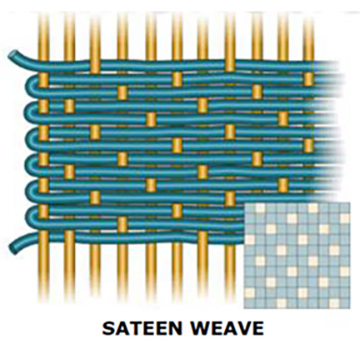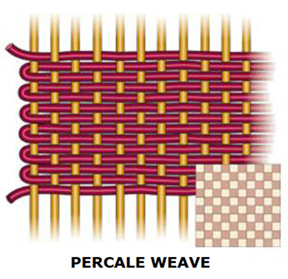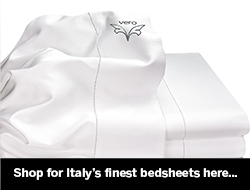Are you considering buying new bed-sheets and you have become overwhelmed with the choices?
To Shop for Italy's finest luxury bed sheets scroll down this page.
Updated 1/2020
As you look around the internet, you will soon discover that the choices for bed sheets are almost unlimited. There are $40 sheet sets and those that are several hundred dollars.
Bed sheets come in several different qualities. The different attributes are often determined by the country that they are manufactured in as well as the grades of cotton or other fibers used in their construction.
Besides the grades of cotton used, there are a variety of different weaves that bed sheets are available in. These weaves can have some, but likely little impact on their price.
Here are some of the more popular weaves found in bed linens.
- Twill
- Jersey Knit
- Flannel
- Percale
- Sateen
- Sateen and percale are the most popular weaves.
Some of the more popular materials used in bedsheets are:
- Cotton
- Wood fiber (bamboo & Modal)
- Satin (polyester)
- Silk
- Linen
- Cotton/Polyester
Cotton is by far the most popular material used in bedsheets.
With regard to weaves, here is an overview of some of the more popular ones.
Sateen:
- A sateen weave is woven on a Jacquard loom. A Jacquard loom has articulating mechanisms that can lift or lower individual warp threads (those that run lengthwise) as the weft thread is passed back and forth across the loom, as shown below. By lifting or lowering these individual threads weft threads can be skipped. By weaving fabric in a Jacquard loom, intricate patterns to be created in the fabric.
- Sateen fabrics are typically smoother and silkier than many other types of weaves.
- Sateen fabrics often have a smoother hand and drape.
- Higher thread counts can also be achieved in sateen fabrics. Some manufacturers offer thread counts as high as 1020 threads per inch.

Percale:
- A percale weave is the strongest weave. A percale weave is achieved by passing one weft thread over one warp thread and then under the next warp thread and so on.
- Percale weaves yield a cooler (to the touch) fabric.
- Percale weaves can have a velvety feel.
- Percale is an excellent fabric for those that sleep hot.
- 800 thread count can be achieved in some percale fabrics.
- We don’t recommend a percale fabric under 200 thread count.
- However, keep in mind just because a sheet may be labeled a certain thread count, the grade of cotton is more important than the thread count.
- As well, some manufacturers have been known to overstate thread counts.

Twill:
- Twill fabrics are woven with a pattern of diagonal parallel ribs.
- Twill is occasionally found in bed linens.
- The ribbed pattern, however, may feel rough to the touch.

Jersey Knit:
- A jersey weave feels much like a T-shirt.
- Jersey sheets are stretchy.
- Jersey is not as durable as other weaves and is generally inexpensive.
- Jersey sheets may also be more likely to pill.
Flannel:
- Flannel sheets are woven with a nap.
- This nap provides a soft feeling and is often sought after in cool weather.
- As a result of this nap, some find flannel sheets create more friction between the person sleeping in them, especially if they are wearing flannel pajamas or pajamas that have a texture.
- Flannel sheets are generally inexpensive and not as durable as other weaves.
Satin:
- Satin, unlike sateen, is not a weave.
- Satin sheets are slippery and clingy.
- Because they are often synthetic, they can feel hot, as polyester does not breathe as well as natural fibers.
- They easily wrinkle and can melt when exposed to a hot iron.
- Satin sheets can snag easily.
- They are often found in the colors red and black (we’re not sure why).
All things equal (same grade of cotton, same weave, etc.), thread-count can become a factor.
One can find a better feeling 200-thread count sheet that is made from an exceptional grade of cotton than a 600-thread count sheet made from a poor grade.
To understand why thread count is not that vital click here.

You may have spent more on a pair of shoes then a great set of sheets and your sheets will never go out of style, they won’t hurt your feet as some high fashion shoes will and you will love them every night for the next 6 to 10 years.
- You deserve to pamper yourself a little – don’t you?
Okay, now you know everything you ever needed to know about bed linen weaves and then some.
Bedding Fabric FAQ
What is thread count?
- Thread count is the count of warp threads and weft threads in one inch of fabric.
- Thread count is not the determining factor of a bed sheets quality.
- Learn more about thread count and why it is a secondary consideration when selecting bedsheets in our article “What is thread count.”
What is the best way to care for bed sheets?
- Warm water, cool/medium dryer temperature.
- No Bleach.
- Mild detergent.
- Read our article “How to properly care for bed sheets.”
How to get wrinkles out of bedsheets.
- Ironing is the best way, but not the only way.
- View our article on “How to remove wrinkles in bedsheets without an iron.”
What causes pilling of bed sheets?
There are a number of conditions that can cause pilling of bed sheets, including being exposed to harsh detergents or high heat. The pilling could also be caused by abrasion from body hair stubble. Or it could simply be that the sheets are made from a poor grade of cotton. To find out more about why bed sheets pill and how to avoid this, click on our article "Why Do Bedsheets Pill?"
